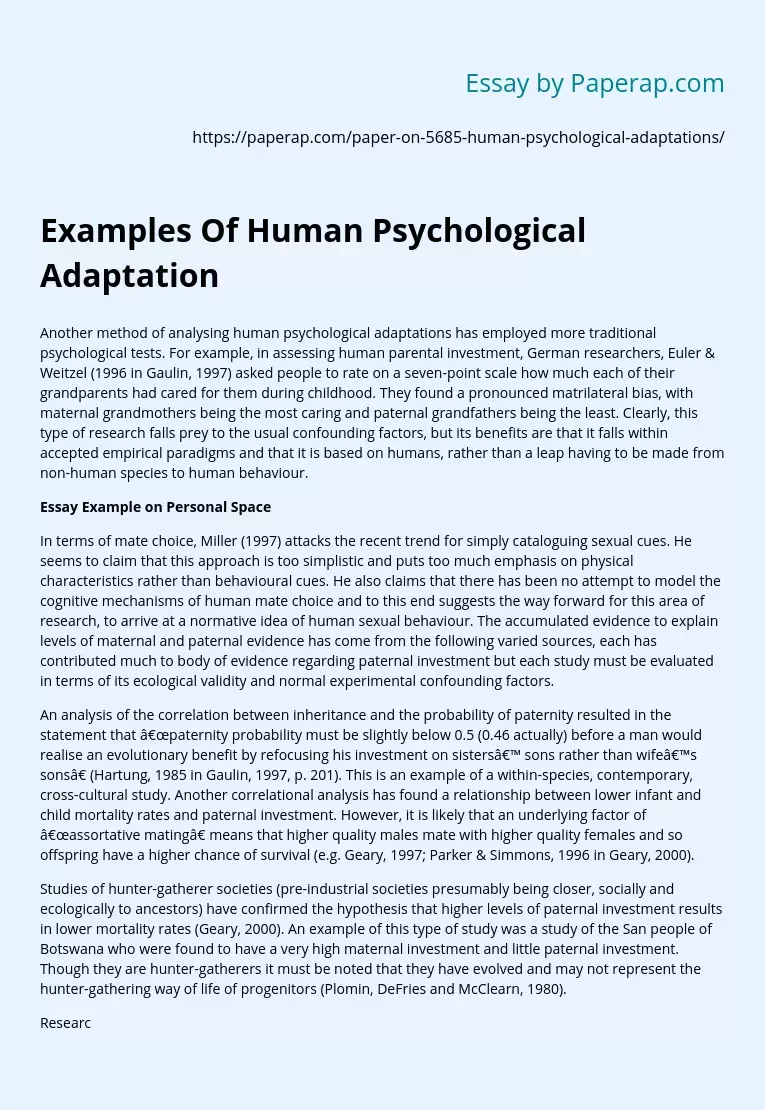Examples Of Human Psychological Adaptation
Another method of analysing human psychological adaptations has employed more traditional psychological tests. For example, in assessing human parental investment, German researchers, Euler & Weitzel (1996 in Gaulin, 1997) asked people to rate on a seven-point scale how much each of their grandparents had cared for them during childhood. They found a pronounced matrilateral bias, with maternal grandmothers being the most caring and paternal grandfathers being the least. Clearly, this type of research falls prey to the usual confounding factors, but its benefits are that it falls within accepted empirical paradigms and that it is based on humans, rather than a leap having to be made from non-human species to human behaviour.
Essay Example on Personal Space
In terms of mate choice, Miller (1997) attacks the recent trend for simply cataloguing sexual cues. He seems to claim that this approach is too simplistic and puts too much emphasis on physical characteristics rather than behavioural cues. He also claims that there has been no attempt to model the cognitive mechanisms of human mate choice and to this end suggests the way forward for this area of research, to arrive at a normative idea of human sexual behaviour.
The accumulated evidence to explain levels of maternal and paternal evidence has come from the following varied sources, each has contributed much to body of evidence regarding paternal investment but each study must be evaluated in terms of its ecological validity and normal experimental confounding factors.
An analysis of the correlation between inheritance and the probability of paternity resulted in the statement that “paternity probability must be slightly below 0.
5 (0.46 actually) before a man would realise an evolutionary benefit by refocusing his investment on sisters’ sons rather than wife’s sons” (Hartung, 1985 in Gaulin, 1997, p. 201). This is an example of a within-species, contemporary, cross-cultural study. Another correlational analysis has found a relationship between lower infant and child mortality rates and paternal investment. However, it is likely that an underlying factor of “assortative mating” means that higher quality males mate with higher quality females and so offspring have a higher chance of survival (e.g. Geary, 1997; Parker & Simmons, 1996 in Geary, 2000).
Studies of hunter-gatherer societies (pre-industrial societies presumably being closer, socially and ecologically to ancestors) have confirmed the hypothesis that higher levels of paternal investment results in lower mortality rates (Geary, 2000). An example of this type of study was a study of the San people of Botswana who were found to have a very high maternal investment and little paternal investment. Though they are hunter-gatherers it must be noted that they have evolved and may not represent the hunter-gathering way of life of progenitors (Plomin, DeFries and McClearn, 1980).
Research on how human behaviour has evolved in terms of mating and parenting has seen the gamut of psychological research – from comparative methods to cross-cultural correlational studies. But while research methods have changed, in fact the theories of these factors of behaviour have not – Darwin’s theories are still valid. Individuals, through evolution, have been ingrained with genes that benefited their reproductive success. That is, their mating behaviour, mate choice and parental investment have evolved so that individuals are programmed to reproduce effectively.
References
Cartwright, J. (2000). Evolution and Human Behaviour. London: Macmillan Press Ltd. Sherry, D. F. (1997). Cross Species comparisons. In Ciba Foundation Symposium. Characterizing Human Psychological Adaptations. Chichester: John Wiley & Sons Ltd. Geary, D. C. (2000). Evolution and Proximate Expression of Human Paternal Investment. In Psychological Bulletin, 126 (1), 55-77. Gleitman, H. et al. (1999). Psychology. 5th Ed. New York & London: W. W. Norton & Company.
Examples Of Human Psychological Adaptation. (2019, Nov 27). Retrieved from https://paperap.com/paper-on-5685-human-psychological-adaptations/

